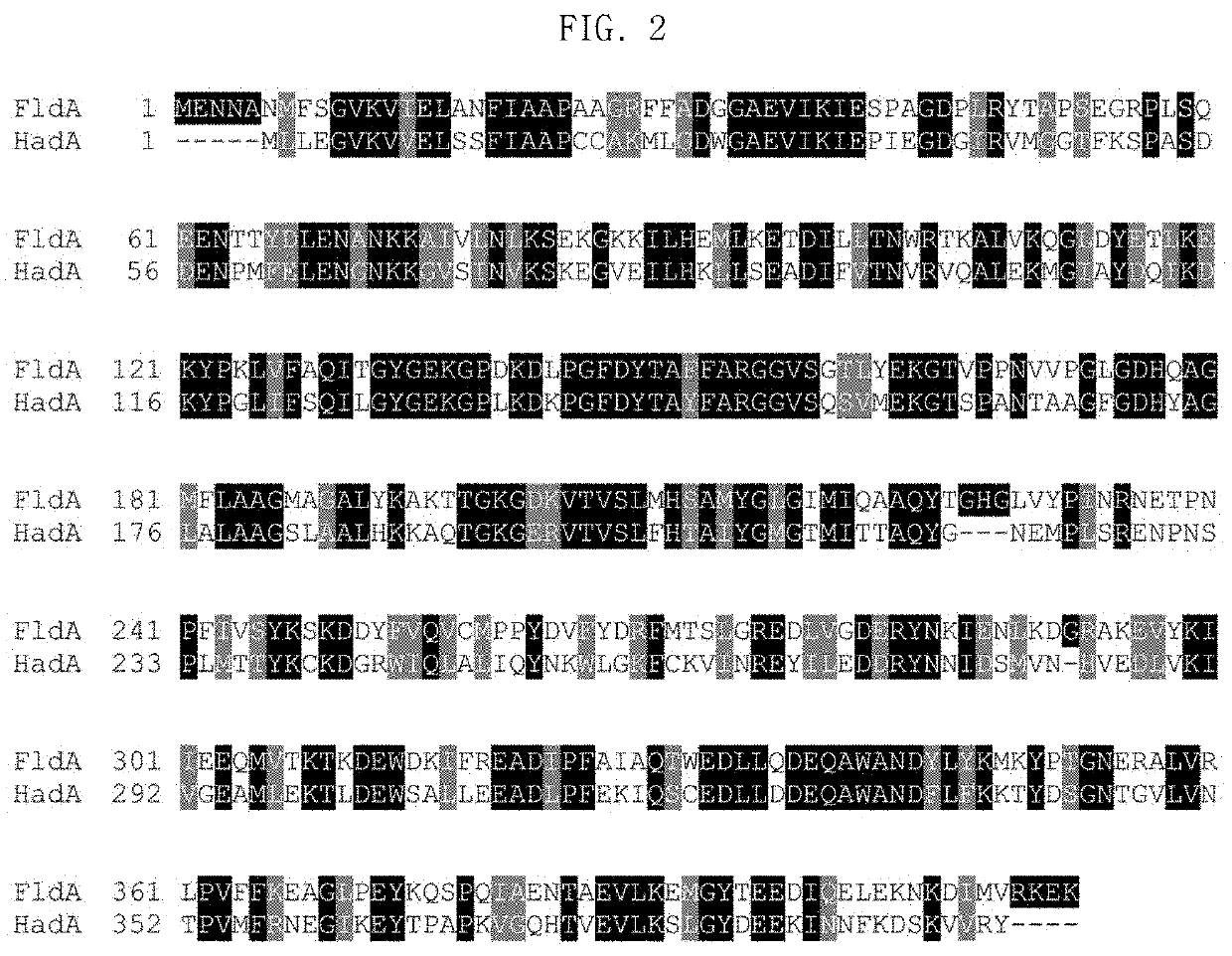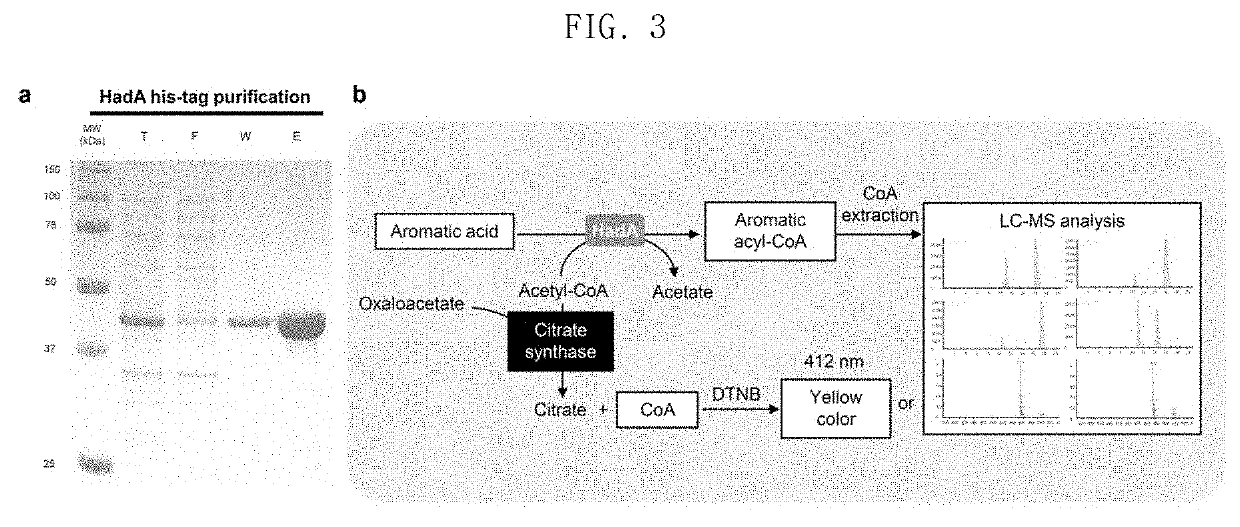Method for producing polyhydroxyalkanoate using 2-hydroxyisocaproate-coa transferase
a technology of 2-hydroxyisocaproate and transferase, which is applied in the direction of transferase, lysine, enzymology, etc., can solve the problems of crystal thermoplastic materials and easy breakag
- Summary
- Abstract
- Description
- Claims
- Application Information
AI Technical Summary
Benefits of technology
Problems solved by technology
Method used
Image
Examples
example 2
Identification of Substrate Diversity of 2-Hydroxyisocaproate CoA-Transferase
[0115]In order to identify whether or not HadA is capable of using acetyl-CoA as a donor, in-vitro assays were performed using HadA prepared in Example 1.
[0116]10 μg of HadA was added to 50 mM phosphate buffer (pH 7.5) containing 0.1 mM acetyl-CoA and a 10 mM substrate, and the reaction was carried out at 30° C. for 10 minutes. After the reaction, 0.1 mM oxaloacetic acid, 5 μg of citrate synthase and 0.5 mM 5.5′-dithiobis-(2-nitrobenzoic acid) (DTNB) were added. Then, the amount of released CoA was analyzed by measuring the absorbance at 412 nm (FIG. 3B).
[0117]Analysis of the resulting aliphatic and aromatic acyl-CoA was performed on LC-MS (Agilent 1100 series and LC / MSD VL, Agilent) equipped with an Eclipse XDB-C18 column (5 μm, 4.6×150 mm, Agilent).
[0118]As a result, as can be seen from FIG. 4, HadA is capable of using acetyl-CoA as a donor and of using mandelate, 4-hydroxymandelate, phenyllactate, 4-hydr...
example 3
Production of Recombinant Strain with Increased Aromatic Monomer Production
[0120]E. coli was engineered to produce D-phenyllactate from glucose in vivo. The biosynthesis of aromatic compounds begins with the synthesis of 3-deoxy-D-arabino-heptulosonate-7-phosphate (DAHP), which is synthesized by the condensation of phosphoenolpyruvate (PEP) and erythrose-4-phosphate (E4P). The produced DAHP is converted into phenylpyruvate (PPA), which is then converted into D-phenyllactate through D-lactate dehydrogenase (FldH) (FIG. 1). The metabolic pathway for aromatic compound biosynthesis is known to be controlled by various inhibition mechanisms in a complicated manner. The expression of the DAHP synthase encoded by aroG and the chorismate mutase / prephenate dehydrogenase encoded by pheA is inhibited by L-phenylalanine (Ribe, D. E. et al., J. Bacteriol. 127:1085, 1976).
[0121]In the present invention, feedback-inhibition-resistant mutants, AroGfbr [AroG (D146N)] and PheAfbr [PheA (T326P)], were...
example 4
Preparation of Polyhydroxyalkanoate Containing Aromatic Monomer using Recombinant Strain
[0138]In order to prevent the formation of D-lactate in XB201TBA, the ldhA gene was further deleted to prepare XB201TBAL strain. In order to prepare polyhydroxyalkanoate containing aromatic monomers, PhaC1437 and HadA were expressed in the E. coli XB201TBAL strain.
[0139]In order to prepare a recombinant vector containing genes encoding PhaC1437 and HadA, PCR was performed using HadA-sbF and HadA-ndR as primers and the chromosomal DNA of Clostridium difficile 630 strain as a template, to produce a hadA gene fragment encoding a hydroxyisocaproate-CoA transferase. The amplified PCR product was ligated with p619C1437-pct540 (Yang, T. H. et al. Biotechnol. Bioeng. 105: 150, 2010) using restriction enzymes (SbfI / NdeI) to obtain p619C1437-HadA. The obtained p619C1437-HadA was introduced into E. coli XB201TBAL to prepare recombinant E. coli expressing AroGfbr, PheAfbr, FldH, PhaC1437 and HadA. The E. col...
PUM
| Property | Measurement | Unit |
|---|---|---|
| Tg | aaaaa | aaaaa |
| Tg | aaaaa | aaaaa |
| pH | aaaaa | aaaaa |
Abstract
Description
Claims
Application Information
 Login to View More
Login to View More - R&D
- Intellectual Property
- Life Sciences
- Materials
- Tech Scout
- Unparalleled Data Quality
- Higher Quality Content
- 60% Fewer Hallucinations
Browse by: Latest US Patents, China's latest patents, Technical Efficacy Thesaurus, Application Domain, Technology Topic, Popular Technical Reports.
© 2025 PatSnap. All rights reserved.Legal|Privacy policy|Modern Slavery Act Transparency Statement|Sitemap|About US| Contact US: help@patsnap.com



